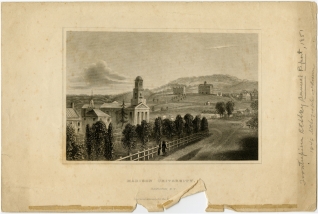August 10 setting aside the election of Education Society Trustees in 1848 and directing that the organization choose a new Board. When his order reached Hamilton on August 13 during commencement week, the Society’s Executive Committee, on the advice of Judges Mason and Nye, announced that the annual meeting would be held the next day. This move took the friends of Rochester by surprise since a three-week notice had been customary and consequently they were unable to muster many of their supporters.
More than sixty members of the Society assembled for a lengthy but courteous and dignified session in contrast to the one held the year before. They repealed the amendment to the constitution adopted in 1848 providing for the election of Trustees by classes and chose a new Board almost identical with that elected in 1847; Deacon William Cobb was again President. Removal was not openly discussed since Hamiltonians were content to await the decision of the court in the Havens and Wiley case. Professor Raymond considered the meeting “a most bald & bare face piece of trickery, practiced under the direction & control of … [local] lawyers, for the purpose of tying up the Ed. Soc. & making it over into the power of Hamilton citizens for ever & ever.”
Some of the Trustees of both Boards, as disgusted as Raymond at the turn of events, proposed that the Baptists of the State meet in Albany to settle the Removal question once and for all.
The obstructionist legal tactics used by the friends of Hamilton were proving effective. The Babcock injunction had thwarted the Removalists at Albany in June, 1849, and Judge Allen’s final decision in August had unseated several of their Trustees from the Education Society Board. In the pending Havens and Wiley suit the temporary injunction of January 23, 1849, had prohibited both Boards from taking steps for removal. When this case came before Judge Allen on August 20, 1849, for final action, he ruled that the temporary injunction must be vacated since the plaintiffs could not show that they were founders of the Society or parties to the original contract for location and hence did not have sufficient interest to bring suit. He did indicate, however, that he believed the Society had no right to remove the institution.
At this juncture the friends of Hamilton turned to Daniel Hascall as a proper plaintiff to represent them. Of his signing the contract and his intimate connection with the Society there was, of course, no doubt. From the first he had become convinced that removal was wrong and





